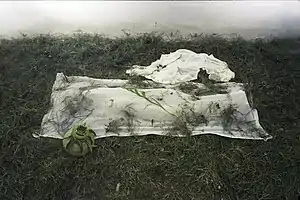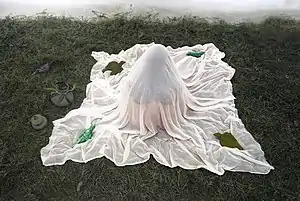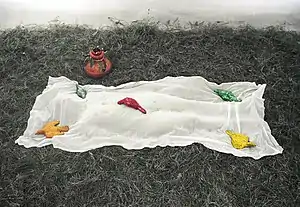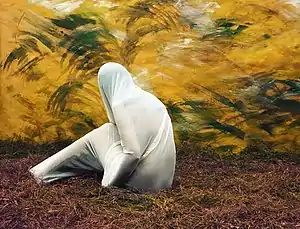Diwan Manna
Diwan Manna (born 17 June 1958) is an Indian conceptual artist and photographer. He completed his study in graphic art and printmaking from the Government College of Art, Chandigarh in 1982.[1][2] He exhibited in India, United Kingdom, Germany, France, Poland, and Italy. From 2014-15 he served as the director of Triennale India, organised by Lalit Kala Akademi, National Academy of Art, Ministry of Culture, Govt of India.[3] He served as the chairman of Chandigarh Lalit Kala Akademi, State Academy of Art, Department of Culture, Chandigarh Administration. Currently, he is serving as the president of Punjab Lalit Kala Akademi, State Academy of Art, Ministry of Culture, Government of Punjab, India.[4]
Diwan Manna | |
|---|---|
 | |
| Born | 1958 (age 62–63) |
| Nationality | Indian |
| Alma mater | Government College of Art, Chandigarh |
| Known for | Conceptual photography |
| Awards | National Academy Award (by Lalit Kala Akademi) |
| Website | Official website |
He is a recipient of the National Academy Award by the Lalit Kala Akademi, New Delhi.[5] Some of his artworks include Alienation (1980), Violence (1985), Waking the Dead (1996), Shores of the Unknown (2000), After the Turmoil (2003), and Master of Light, and Le Corbusier (2006).
Early life
Manna was born in 1958, in Bareta,[6][5] a town in Bathinda district (now Mansa district) of Punjab, India.[2] He completed his matriculation from the Government High School, Bareta in 1975. In his early years, he studied fiction and poetry, and was active in sports, played leading role as an actor in theatre and local Ramlila, a popular theatrical folk form in India.[7][4]
He studied printmaking at the Government College of Art, Chandigarh, India, from 1978 to 1982.[1][2]
Career
Manna has been practising art since 1980. In 2006, he was artist in residence at Firminy, Saint-Etienne, France, as a part of a cultural exchange program to photograph architecture of Le Corbusier.[8][9]
On 17 June 2008, he was appointed the chairman of Chandigarh Lalit Kala Akademi, and held the position until 31 July 2015.[6] From 2014-15 he served as the director of Triennale India, organised by Lalit Kala Akademi India's National Academy of Arts, Ministry of Culture, Govt of India.[3] Since 2016, he is the president of Punjab Lalit Kala Akademi.[4]

Awards
He is a recipient of the National Academy Award by Lalit Kala Akademi.[2][10] He first received the All India Fine Arts and Crafts Society award in 1995, and the second time in 1996.[11]
Artworks
Manna is one of the first artists from India to practice conceptual photography.[12] His work combines images with objects, moving within a consciously chosen space in order to create a multimedia reality.[13]
He is known for his work revolving around socio-cultural and socio-political concerns,[14] in which he depicts the collapse of human sensitivities in the face of violence, turbulence, hypocrisy, alienation, dehumanization, war and death.[15] According to the art historian Raffael Dedo Gadebusch in The Museum's Journal, Berlin, "...a rather thoughtfull laconic picture of the social reality emerges from Manna's compositions...". [16]
By using existing icons and symbols of tradition and culture as a reference point, he creates visuals, which acquire a deeper meaning in the mind of the viewer, leading to a multitude of interpretations. His interest does not lie in creating pretty visuals but to transport the viewers from the image into their own perceived, imagined and lived experiences by inviting them to respond to these.[17]
Diwan has pushed the boundaries of photography by developing a technique of combining painting, acting, and photography to narrate his personal impressions and experiences of the world in and around him. He creates a three-dimensional immersive environment in which there is a painting in the backdrop, actors whose bodies are painted and props[14] created specifically around the themes he is working on (in the series Violence, Waking the Dead, Shores of the Unknown and After the Turmoil).[18] This temporary installation of various elements is photographed on a transparency film which is further exposed in the darkroom on a normal photographic paper by controlling the rendition of images with the play of filters.[17]
His artworks are not frozen mirror images of banal objects but there is certain remoteness from a routine visual experience.[19] Camera for him is not merely a copying device to document[17] the existing reality around him rather he constructs it in an effort to look beyond the obvious. He is often seen in the images (series - Waking the Dead, Shores of the Unknown and After the Turmoil), outside it, besides it, looking at it and looking from it thereby inhabiting space which is inner (mind), real (studio) and the social at the same time.[20] His conceptual artworks began with the series Alienation in 1980 and continued with the series Violence, Waking the Dead, Shores of the Unknown, After the Turmoil, Master of Light-Le Corbusier[21] over the next three decades.[19] Through his works, Manna tries to express his concerns about the working class and the social inequality in Indian society.[9]

Some of his artworks include:
- Alienation (1980); 8 photographs created in 1980 revolving around the life of peons in the Government College of Art, Chandigarh, symbolizing increasing alienation in society.[6][22]
- Dhaba (1987); photographs metaphorically representing darkness in the lives of workers in the local eateries.
- Waking the Dead (1996); series around various facets of death and life.[22][7]
- Shores of the Unknown (2000); The unknown could be the expanse of private memory, the darkness of the collective unconscious, contemporary history, living environment and often the intersection of these spaces. An endless reflection of human predicaments characterizing the complex emotions that death evokes in us. These are the artworks in which Manna himself steps in as an actor to transcend and transform the scene.[6][22]
- After the Turmoil (2003); based on the theme of optimism trying to come to terms with traumatic past and its newfound freedom.[22][6]
- Violence (1985); work around insidious and unrecognized forms of degradation of a sense of life and honor within ourselves as well as in others.[6]
- Master of Light, Le Corbusier (2006); images based on the modernist architect Le Corbusier's architectural creations. It is an attempt to create an imagery of lyricism, rhythm, and nuances of light, shape, form, volume, and colour based on his encounters with architectural spaces.[22][6][23]
- Corridors of Power (2006); symbolic dimension of the administrative buildings in the Chandigarh Capitol Complex.[24]
Exhibitions
Individual

His individual exhibitions include:[25]
- 2006: Ages of Separation curated by Alka Pande at India Habitat Centre[1]
- 2003: After The Turmoil at International Art Centre, Paszkowka Palace, Kraków, Poland.
- 2001: Window on Time at Galerie Bateau Lavoir, Paris, France.
- 2000: Wheel of Time at Alliance Francaise de Chandigarh, India
- 2000: Alienation, Violence, Dhaba, Goat's Eye and Shores of the Unknown at Museum of Asian Art, Berlin, Germany[6]
- 2000: Shores of the Unknown at Galerie Bellevue, Berlin, Germany
- 1999: Rooh Punjab Di curated by Alka Pande at Sector 17, Chandigarh, India
- 1997: Waking the Dead at Rowley's Museum, Shrewsbury, UK
Group Exhibitions

His work has been exhibited in some group exhibitions, including:[25]
- 2016: Bodhgaya Biennale[26]
- 2016: Le Corbusier - Mastering the Image in India, in collaboration with Museum of Fine Arts, La-Chaux-de-Fonds, Switzerland, and Fondation Le Corbusier, France, at NGMA, Bangalore, at Embassy of Switzerland in Nov 2015 and at Govt. Museum & Art Gallery, Chandigarh, October 2015, curated by Sphie Vantieghem[27][28]
- 2011: Articulate 2011 - An Exhibition of Contemporary photography- Saffron Art and Pratham, UK, Bond Street, London, UK
- 2011: 150 Years of Income Tax in India- Lalit Kala Akademi Galleries, New Delhi, Chandigarh, Lucknow, and Jaipur.
- 2009: The Wonder that is India- A Visual Map, group exhibition of 8 Photographers, curated by Alka Pande, collateral event India Art Summit, Instituto Cervantes Nueva, Delhi.
- 2008: Click! Contemporary Photography in India, curated by Suneil Gupta and Radhika Singh, at Vadehra Art Gallery in collaboration with Photomedia, New Delhi, India and Grosvenor Gallery, London
- 2007-2008: Regards Croises Franco - Indien (Indo - French Glances) Firminy-Chandigarh, Le Corbusier, by Diwan Manna and Michel Dieudonne, curated by Martine Dancer, at Alliance Francaise de Chandigarh, Apparao Gallery Chennai, Gallery Romaine Rolland, Alliance Francaise de Delhi, April, Alliance Francaise Trivandrum, Alliance Francaise Kolkata, Alliance Francaise, Bangalore
- 2007: Brasilia-Chandigarh-Le Havre, Portraits de Villes, Musee Malraux, curated by Annette Haudiquet, Le Havre, France[29]
- 2006-2007: Regards Croises Franco - Indien (Indo - French Glances) Firminy-Chandigarh, Le Corbusier, by Diwan Manna and Michel Dieudonne, curated by Martine Dancer at Unite de la Habitation, Firminy, St-Etienne, France[30]
- 2006-2007: Lille 2007, Le Corbusier a Chandigarh 1951-2006, by Diwan Manna, Stephane Couturier, and Lucien Harve, curated by Yannick Courbes, Musee des Beaux-Arts, Tourcoing, Lille, France
- 2005: Decisive Moment, New Delhi, India
- 2004: Singular Identities, curated by Alka Pande, at India Habitat Center
- 2000: Group show of five artists at Alliance Francaise, Chandigarh, India
- 1997: Five Artists from Punjab, Galleries of English Bridge Workshop, Abbey Foregate, Shrewsbury, UK
- 1997: Yesterday, Today and Tomorrow, Government Museum and Art Gallery, Chandigarh, India
- 1996: 3rd All India Photography Exhibition, All India Fine Arts and Crafts Society, New Delhi and Chandigarh, India
- 1996: National Exhibition of Photography, Lalit Kala Akademi, Delhi, India
- 1995: 2nd All India Photography Exhibition, All India Fine Arts and Crafts Society, New Delhi and Chandigarh, India
- 1995: Project Punjab at National Gallery of Modern Art, New Delhi, Mumbai, Chandigarh, India and UK
- 1993: South Asian Visual Arts Festival, Wolverhampton Art Gallery, UK
- 1988: International Exhibition of Graphic Art & Photography, All India Fine Arts and Crafts Society, New Delhi, India
- 1982: National Exhibition of Art, Lalit Kala Akademi, Delhi, India
References
- "A unique combination". Thehindu.com. 13 September 2006. Retrieved 20 January 2018.
- "A unique combination". The Hindu. Retrieved 6 July 2017.
- "Peripheries of Globalization : Re-mapping the global contemporary through biennales and triennales" (PDF). Indiaculture.nic.in. Retrieved 20 January 2018.
- "'Functioning of Akademies should be left to professionals': Diwan Manna". The Indian Express. 3 October 2016. Retrieved 6 July 2017.
- "The nuances of conceptual photography defy mediums". Sunday-guardian.com. Retrieved 20 January 2018.
- "The Sunday Tribune - Spectrum". Tribuneindia.com. Retrieved 20 January 2018.
- "Diwan Manna wins All India Fine Arts & Crafts Society's national awards for his photography". India Today. 15 September 1996. Retrieved 20 January 2018.
- History and Heritage - Government College of Art, Chandigarh (India) (first ed.). D S Kapoor. p. 286. ISBN 978-93-5279-401-0.
- Contemporary Art North India. Pentagon Press. pp. 109–114. ISBN 978-81-8274-949-8.
- "Diwan Manna | Paintings by Diwan Manna | Diwan Manna Painting - Saffronart.com". Saffronart. Retrieved 6 July 2017.
- "Of Tradition and Change". Art India : The Art News Magazine of India. Vol. 3 no. 2. Mumbai: Art India Publishing Company. 1998. pp. 66–68. OCLC 80022104.
- "Art is the Art of Going Beyond the Obvious". www.betterphography.in. Retrieved 5 October 2016.
- on Art, Take (January–June 2018). "Symphony of Light". 4 (22): 36–37, 39. Cite journal requires
|journal=(help) - >Cichocka, Marta Eloy (December 2006). "Cisza Po Burzy". Biuletyn Fotograficzny. 26: 20,21,22.
- Lal, Pradyot (August 1997). "Language of the lens". Asian Age.
- >Gadebusch, Raffael Dedo (April 2002). "New acquisitions at the Museum for Indian Art". Museum's Journal. I6 (II): 70,71. ISSN 0933-0593.
- Pande, Alka (January 1998). "Of Tradition and Change". The Art News Magazine of India. 3 (2): 66 - 68.
- "Diwan Manna: Artist or a Photographer". India Monitor. 26 November 1995.
- Singh, Amarbir (2006). 'Ages of Separation by Diwan Manna'. New Delhi: Exhibition Catalog, Visual Arts Gallery
- Amarbir Singh (October 2006). Pande, Dr Alka (ed.). Ages of Separation. New Delhi: Gallery Artroom. p. 2.
- "Regards croisés sur l'architecture: Le Corbusier vu par ses photographes".ISBN 9782859446666
- "The Tribune - Magazine section - Windows". Tribuneindia.com. Retrieved 20 January 2018.
- Manna, Diwan (January–June 2018). "Symphony Of Light". Take on India. Vol. 4 no. 1. pp. 36–39. OCLC 921866684.
- "Brasilia Chandigarh Le Havre Portraits of cities". Retrieved 2 June 2016.
- "Diwan Manna - Chandigarh Lalit Kala Akademy". Lalitkalachandigarh.com. Retrieved 20 January 2018.
- "World art on one platform - Bodhgaya Biennale - The Tetegraph, Calcutta - Diwan Manna". Diwanmanna.com. Retrieved 20 January 2018.
- "Mastering the Image" (PDF). Chaux-de-fonds.ch. Retrieved 20 January 2018.
- "'Le Corbusier – Mastering the Image' Exhibition". Swissnexindia.org. Retrieved 20 January 2018.
- "BRASILIA – CHANDIGARH – LE HAVRE : PORTRAITS DE VILLES" (PDF). Muma-lehavre.fr. 16 September 2007. Retrieved 20 January 2018.
- "Tale of two cities - The Hindu, India - Diwan Manna". Diwanmanna.com. Retrieved 20 January 2018.